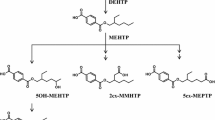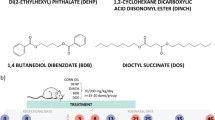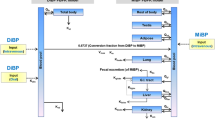Abstract
Di(2-ethylhexyl) phthalate (DEHP) is used as a plastic softener in the polymer industry and is widespread in medical devices. DEHP has been incriminated as an endocrine-disrupting chemical, and the effects of DEHP in various species have included disturbances in the reproductive system. The effects of the chemical have varied, depending upon exposure routes and species. This study was performed in order to characterise the kinetics of DEHP and its metabolite mono(2-ethylhexyl) phthalate (MEHP) in the young male pig, an omnivore model-species for research in reproductive toxicology. Eight pigs were given 1000 mg DEHP/kg bodyweight by oral gavage. The concentrations of DEHP and MEHP were then measured in the plasma and tissues of the pigs at different time points after administration. There was no consistent rise above contamination levels of concentrations of DEHP in the plasma of the pigs. However, the metabolite MEHP reached the systemic blood circulation. The half-life of MEHP in the systemic blood circulation was calculated to be 6.3 h. Absorption from the intestine was biphasic in six of the eight pigs and the mono-exponential elimination-phase started 16 h after the after the administration of DEHP. To conclude, MEHP consistently reaches the systemic circulation in the pig when DEHP is administered orally. The kinetic pattern of the parent substance on the other hand is more difficult to characterise.


Similar content being viewed by others
References
Akingbemi BT, Youker RT, Sottas CM, Ge R, Katz E, Klinefelter GR, Zirkin BR, Hardy MP (2001) Modulation of rat Leydig cell steroidogenic function by di(2-ethylhexyl)phthalate. Biol Reprod 65:1252–1259
Albro PW (1986) Absorption, metabolism, and excretion of di(2-ethylhexyl) phthalate by rats and mice. Environ Health Perspect 65:293–298
Albro PW, Corbett JT, Schroeder JL, Jordan S, Matthews HB (1982) Pharmacokinetics, interactions with macromolecules and species differences in metabolism of DEHP. Environ Health Perspect 45:19–25
Almond GW (1996) Research application using pigs. Vet Clin North Am Food Anim Pract 12:707–716
Eastman Kodak Co (1983) Disposition of [2-hexyl14Cdi(2-ethylhexyl) phthalate in the rat. TSCATS: OTS 0206634, Doc. I.D. 878212716, 06-20-83, Eastman Kodak Co
Gaunt IF, Butterworth KR (1982) Autoradiographic study of orally administered di-(2-ethylhexyl) phthalate in the mouse. Food Chem Toxicol 20: 215–217
Gray LE, Ostby J, Furr J, Price M, Veeramachaneni DNR, Parks L (2000) Perinatal exposure to the phthalates DEHP, BBP, and DINP, but not DEP, DMP, or DOTP, alter sexual differentiation of the male rat. Toxicol Sci 58:350–365
Ikeda GJ, Sapienza PP, Couvillion JL, Farber TM, van Loon EJ (1980) Comparative distribution, excretion and metabolism of di-(2-ethylhexyl) phthalate in rats, dogs and miniature pigs. Food Cosmet Toxicol 18:637–642
Jarosová A, Gajdusková V, Raszyk J, Sevela K (1999) Di-2-ethylhexyl phthalate and di-n-butyl phthalate in the tissues of pigs and broiler chicks after their oral administration. Vet Med Czech 44:61–70
Kessler W, Phoka W, Csanády GA, Filser JG (2001) No background concentrations of di(2-ethylhexyl) phthalate and mono(2-ethylhexyl) phthalate in blood of rats. Arch Toxicol 75:62–64
Keys DA, Wallace DG, Kepler TB, Conolly R (1999) Quantitative evaluation of alternative mechanisms of blood and testes disposition of di(2-ethylhexyl) phthalate and mono(2-ethylhexyl) phthalate in rats. Toxicol Sci 49:172–185
Lovekamp TN, Davis BJ (2001) Mono-(2-ethylhexyl) phthalate suppresses aromatase transcript levels and estradiol production in cultured rat granulosa cells. Toxicol Appl Pharmacol 172:217–224
Oishi S, Hiraga K (1982) Distribution and elimination of di-2-ethylhexyl phthalate (DEHP) and mono-2-ethylhexyl phthalate after a single oral administration of DEHP in rats. Arch Toxicol 51:149–155
Pollack GM, Li RCK, Ermer JC, Shen DD (1985) Effects of route of administration and repetitive dosing on the disposition of di(2-ethylhexyl) phthalate and its mono-de-esterified metabolite in rats. Toxicol Appl Pharmacol 79:246–256
Poon R, Lecavalier P, Mueller R, Valli VE, Procter BG, Chu I (1997) Subchronic oral toxicity of di-n-octyl phthalate and di(2-ethylhexyl) phthalate in the rat. Food Chem Toxicol 35:225–239
Pugh G Jr, Isenberg JS, Kamendulis LM, Ackley DC, Clare LJ, Brown R, Lington AW, Smith JH, Klaunig JE (2000) Effects of di-isonyl phthalate, di-2-ethtylhexyl phthalate, and clofibrate in cynomolgus monkeys. Toxicol Sci 56:181–188
Rhodes C, Orton TC, Pratt IS, Batten PL, Bratt H, Jackson SJ, Elcombe CR (1986) Comparative pharmacokinetics and subacute toxicity of di(2-ethylhexyl) phthalate (DEHP) in rats and marmosets: extrapolation of effects in rodents to man. Environ Health Perspect 65:299–308
Safe SH (1998) Hazard and risk assessment of chemical mixtures using the toxic equivalency factor approach. Environ Health Perspect 106 [Suppl 4]:1051–1058
Schmid P, Schlatter C (1985) Secretion and metabolism of di-(2-ethylhexyl) phthalate in man. Xenobiotika 15:251–256
Sjöberg P, Bondesson U, Kjellen L, Lindquist N.-G, Mentin G, Plöen L (1985) Kinetics of di-(2-ethylhexyl) phthalate in mature and immature rats and effects on testis. Acta Pharmacol Toxicol 56:30–37
Sjöberg P, Bondesson U, Gray TJB, Plöen L (1986) Effects of di-(2-ethylhexyl) phthalate and five of its metabolites on rat testis in vivo and in vitro. Acta Pharmacol Toxicol 58:225–233
Tanaka A, Adachi T, Takahashi T, Yamaha T (1975) Biochemical studies on phthalic esters. I. Elimination, distribution and metabolism of di-(2-ethylhexyl) phthalate in rats. Toxicology 4:253–264
Teirlynck OA, Belpaire F (1985) Disposition of orally administered di-(2-ethylhexyl) phthalate and mono-(2-ethylhexyl) phthalate in the rat. Arch Toxicol 57:226–230
White RD, Carter DE, Earnest D, Mueller J (1980) Absorption and metabolism of three phthalate diesters by the rat small intestine. Food Cosmet Toxicol 18:383–386
Acknowledgements
Financial support was provided by the ReproSafe-program of the Swedish Environmental Protection Agency. The European Council of Plasticizers and Intermediates is acknowledged for financial support for performing the DEHP and MEHP analyses. The Ethical Committee on Animal Experiments, Uppsala, Sweden, approved all the procedures described as prescribed by national legislation.
Author information
Authors and Affiliations
Corresponding author
Rights and permissions
About this article
Cite this article
Ljungvall, K., Tienpont, B., David, F. et al. Kinetics of orally administered di(2-ethylhexyl) phthalate and its metabolite, mono(2-ethylhexyl) phthalate, in male pigs. Arch Toxicol 78, 384–389 (2004). https://doi.org/10.1007/s00204-004-0558-z
Received:
Accepted:
Published:
Issue Date:
DOI: https://doi.org/10.1007/s00204-004-0558-z




